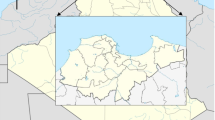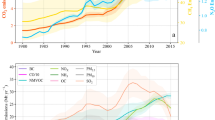Abstract
This study aims to assess the current and future air pollution and associated health impacts in Pakistan. In this study, the Pakistan Integrated Energy Model (Pak-IEM) is used to assess current and future energy consumption in Pakistan. To assess air pollution levels and associated health impacts, we used the Greenhouse gas and Air pollution INteractions and Synergies (GAINS) model. A linkage has been established between both the models to feed the energy outputs from Pak-IEM into GAINS for exploring different scenarios. Mainly, the emissions of three air pollutants (SO2, NOx, and PM2.5) as well as the associated health impacts of increased emissions are assessed. Baseline emission scenario (BES) shows a growth in emissions of SO2, NOx, and PM2.5 by a factor of 2.4, 2.2, and 2.5 between 2007 and 2030. In terms of health impacts, by 2030, annual mean concentrations of fine particles (PM2.5) would increase to more than 150 μg/m3 in some parts of Punjab region of Pakistan, for which loss in statistical life expectancy is calculated to increase from 30 to 60 months in 2007 up to 60–100 months in 2030 on average.










Similar content being viewed by others
Notes
For example, shifting of public transport to compressed natural gas, converting coal power plants to natural gas, introduction of Euro standards in the transport sector, etc.
Million ton oil equivalent
Million vehicle kilometers of travel
The existing air quality monitoring network collects data on total suspended particles (TSP), PM10, NO2, SO2, and CO.
The emission standards for new vehicles are generally different from in-use vehicles, since the needs and test procedures are different. Euro-II standards require three-way catalysts. For heavy-duty diesel vehicles, PM and NOx standards are specified together, since there is a trade-off between these two in terms of engine optimization.
References
Ahmed A (2014) Pakistan’s urban air pollution off the charts: World Bank. DAWN, 14th July 2014 (Available at: http://www.dawn.com/news/1119031/pakistans-urban-air-pollution-off-the-charts-world-bank accessed on 12th June 2016).
Amann M, Bertok I, Borken J, Chambers A, Cofala J, Dentener F, Heyes C, Hoglund L, Klimont Z, Purohit P, Rafaj P, Schöpp W, Toth G, Wagner F, Winiwarter W (2008) GAINS-Asia. A tool to combat air pollution and climate change simultaneously—methodology report. International Institute for Applied Systems Analysis (IIASA), Laxenburg
Amann M, Bertok I, Borken-Kleefeld J, Cofala J, Heyes C, Höglund-Isaksson L, Klimont Z, Nguyen B, Posch M, Rafaj P, Sandler R, Schöpp W, Wagner F, Winiwarter W (2011) Cost-effective control of air quality and greenhouse gases in Europe: modeling and policy applications. Environ Model Softw 26(12):1489–1501. doi:10.1016/j.envsoft.2011.07.012
Ashraf N, Mushtaq M, Sultana B, Iqbal M, Ullah I, Shahid SA (2013) Preliminary monitoring of tropospheric air quality of Lahore City in Pakistan. Int J Chem Biochem Sci 3:19–28
Aziz JA (2006) Towards establishing air quality guidelines for Pakistan. East Mediterr Health J 12(6):886–893
Brauer M, Freedman G, Frostad J, et al. (2016) Ambient air pollution exposure estimation for the global burden of disease 2013. Environ Sci Technol 50(1):79–88. doi:10.1021/acs.est.5b03709
CIA (2016) The World Fact Book 2016. Central Intelligence Agency (CIA), Washington D.C. (Available at: https://www.cia.gov/library/publications/the-world-factbook/geos/print_pk.html accessed on 22nd June 2016)
Colbeck I, Nasir ZA, Ali Z (2010a) The state of ambient air quality in Pakistan—a review. Environ Sci Pollut Res 17(1):49–63. doi:10.1007/s11356-009-0217-2
Colbeck I, Nasir ZA, Ali Z (2010b) The state of indoor air quality in Pakistan—a review. Environ Sci Pollut Res 17(6):1187–1196. doi:10.1007/s11356-010-0293-3
Colbeck I, Nasir ZA, Ali Z (2010c) Characteristics of indoor/outdoor particulate pollution in urban and rural residential environment of Pakistan. Indoor Air 20(1):40–51. doi:10.1111/j.1600-0668.2009.00624.x
Dholakia HH, Purohit P, Rao S, Garg A (2013) Impact of current policies on future air quality and health outcomes in Delhi, India. Atmos Environ 75:241–248. doi:10.1016/j.atmosenv.2013.04.052
EEA (2003) Europe’s environment: the third assessment. Environmental Assessment Report No 10, European Environment Agency (EEA), Copenhagen
Forouzanfar MH, Alexander L, Anderson HR (2015) Global, regional, and national comparative risk assessment of 79 behavioural, environmental and occupational, and metabolic risks or clusters of risks in 188 countries, 1990–2013: a systematic analysis for the Global Burden of Disease Study 2013. Lancet 6736(15):1990–2013. doi:10.1016/S0140-6736(15)00128–2
Gustafsson O, Kruså M, Zencak Z, Sheesley RJ, Granat L, Engström E, Praveen PS, Rao PSP, Leck C, Rodhe H (2009) Brown clouds over South Asia: biomass or fossil fuel combustion? Science 323(5913):495–498. doi:10.1126/science.1164857
HEI (2010) Outdoor air pollution and health in the developing countries of Asia: a comprehensive review. Special Report 18, HEI International Scientific Oversight Committee, Health Effects Institute (HEI), Boston, MA
IPCC (2001) Climate change 2001: the scientific basis. Contribution of Working Group I to the Third Assessment Report of the Intergovernmental Panel on Climate Change [Houghton, J.T., Y. Ding, D.J. Griggs, M. Noguer, P.J. van der Linden, X. Dai, K. Maskell, and C.A. Johnson (eds.)], Cambridge University Press, Cambridge, United Kingdom and New York, NY, USA, pp. 881
Irfan SM (2015) A methodology for modelling energy use in the agriculture sector for the Pakistan integrated energy model. Int J Intell Enterp 5(1):19–37. doi:10.1504/IJIE.2015.073466
Jacob DJ, Winner DA (2009) Effect of climate change on air quality. Atmos Environ 43(1):51–63. doi:10.1016/j.atmosenv.2008.09.051
Khan, SA (2012) EURO-II standards for vehicles from July 1, Dawn, 5th March 2012 (See: http://archives.dawn.com/archives/170323)
Khwaja MA, Khan SR (2005) Air pollution: key environmental issues in Pakistan. Working Paper Series 99, Sustainable Development Policy Institute (SDPI), Islamabad
Klimont Z, Cofala J, Xing J, Wei W, Zhang C, Wang S, Kejun J, Bhandari P, Mathur R, Purohit P, Rafaj P, Chambers A, Amann M, Hao J (2009) Projections of SO2, NOx, and carbonaceous aerosols emissions in Asia. Tellus B: Chem Phys Meteorol 61B(4):602–617. doi:10.1111/j.1600-0889.2009.00428.x
Krol M, Houweling S, Bregman B, van den Broek M, Segers A, van Velthoven P, Peters W, Dentener F, Bergamaschi P (2005) The two-way nested global chemistry-transport zoom model TM5: algorithm and applications. Atmos Chem Phys 5:417–432. doi:10.5194/acp-5-417-2005
Lim SS, Vos T, Flaxman AD, et al. (2012) A comparative risk assessment of burden of disease and injury attributable to 67 risk factors and risk factor clusters in 21 regions, 1990-2010: a systematic analysis for the Global Burden of Disease Study 2010. Lancet 380(9859):2224–2260. doi:10.1016/S0140-6736(12)61766-8
Mansha M, Ghauri B, Rahman S, Amman A (2012) Characterization and source apportionment of ambient air particulate matter (PM2.5) in Karachi. Sci Total Environ 425:176–183. doi:10.1016/j.scitotenv.2011.10.056
MoCC (2012) National Climate Change Policy. Ministry of Climate Change (MoCC), Government of Pakistan, Islamabad
MoE (2005) National Environmental Policy (NEP) 2005. Ministry of Environment (MOE), Government of Pakistan, Islamabad
MoF (2015) Pakistan Economic Survey 2015–16. Ministry of Finance (MoF), Govt. of Pakistan, Islamabad
MoPDR (2015) Annual Plan 2015–16. Ministry of Planning, Development & Reform (MoPDR), Government of Pakistan, Islamabad
Pak-EPA (2005) Position paper for environmental quality standards for noise in Pakistan. Pakistan Environmental Protection Agency (Pak-EPA), Islamabad (See: http://www.environment.gov.pk/pro_pdf/noisepapergen.pdf).
Pak-IEM Model (2010) Pakistan Integrated Energy (Pak-IEM): model design report. International Resources Group for Asian Development Bank (ADB) and Ministry of Planning and Development (MOPD), Government of Pakistan, Islamabad
Pak-IEM Model (2011) Pakistan Integrated Energy (Pak-IEM): model final report volume I. International Resources Group for Asian Development Bank (ADB) and Ministry of Planning and Development (MOPD), Government of Pakistan, Islamabad
Parekh PP, Khwaja HA, Khan AR, Naqvi RR, Malik A, Shah SA, Khan K, Hussain G (2001) Ambient air quality of two metropolitan cities of Pakistan and its health implications. Atmos Environ 35(34):5971–5978. doi:10.1016/S1352-2310(00)00569-0
PBC 2011 Integrated energy planning and Pakistan’s energy future—a PBC position paper. Energy Expert Group, Pakistan Business Council (PBC), Karachi
PEPA (1997) Pakistan Environmental Protection Act (PEPA), 1997. The Gazette of Pakistan, Islamabad (See: http://www.environment.gov.pk/act-rules/envprotact1997.pdf).
Purohit P, Amann M, Mathur R, Bhandari P, Bertok I, Borken J, Cofala J, Heyes C, Klimont Z, Rafaj P, Schöpp W, Wagner F, Winiwarter W (2010) GAINS-Asia. Scenarios for cost-effective control of air pollution and greenhouse gases in India. International Institute for Applied Systems Analysis (IIASA), Laxenburg
Purohit P, Munir T, Rafaj P (2013) Scenario analysis of strategies to control air pollution in Pakistan. J Integr Environ Sci 10(2):77–91. doi:10.1080/1943815X.2013.782877
Rasheed A, Aneja VP, Aiyyer A, Rafique U (2014) Measurements and analysis of air quality in Islamabad, Pakistan. Earth’s Futur 2(6):303–330. doi:10.1002/2013EF000174
Rupakheti M, Nakajima T (2011) Satellite view of particulate pollution in the Hindu Kush-Himalayas. Sustain Mt Dev 60:13–16
Sánchez-Triana E, Enriquez S, Afzal J, Nakagawa A, Khan AS (2014) Cleaning Pakistan’s air: policy options to address the cost of outdoor air pollution. Washington, DC: World Bank. doi:10.1596/978-1-4648-0235-5
Schwela D (2007) Noise policies in Southeast Asia. Noise News International 15(1):14–21
Shahid I (2007) Development of the GAINS-Asia Model for Pakistan. International Institute for Applied Systems Analysis (IIASA), Laxenburg
Sohail MT, Delin H, Talib MA, Xiaoqing X, Akhtar MM (2014) An analysis of environmental law in Pakistan: policy and conditions of implementation. Res J Appl Sci Eng Technol 8(5):644–653
UNEP (2001) Asia–Pacific Environment Outlook. United Nations Environment Program (UNEP), Regional Resource Centre for Asia and the Pacific (RRCAP), Thailand (See: http://www.rrcap.ait.asia/pub/eo/apeo/apeo2/toc.pdf)
UNEP (2015) Air quality policies—Pakistan. United Nations Environment Program (UNEP) (Available at: http://www.unep.org/transport/airquality/Pakistan.pdf)
UNFCCC (2015 Pakistan—Intended Nationally Determined Contributions (INDCs). Submitted by the Government of Pakistan to the United Nations Framework Convention on Climate Change (UNFCCC), Bonn
WHO (2006) Air quality guidelines for particulate matter, ozone, nitrogen dioxide and sulphur dioxide: global update 2005—summary of risk assessment. World health Organization (WHO), Geneva
WHO (2009) Pakistan: country profile of environmental burden of disease. World Health Organization (WHO), Geneva (Available at: www.who.int/quantifying_ehimpacts/national/countryprofile/pakistan.pdf?ua=1).
Acknowledgments
The authors thank the three anonymous reviewers for their comments and inputs on earlier versions of this paper.
Author information
Authors and Affiliations
Corresponding author
Additional information
Responsible editor: Gerhard Lammel
Appendix
Appendix
The Pak-IEM model was built around the MARKAL/TIMES modeling environment. A MARKAL/TIMES model requires a core set of data to characterize the energy system that the model represents. Once constructed, the model solves for the least-cost solution that utilizes the available energy carriers (fuels, electricity, heat) and technologies (power plants, refineries, end-use devices) to meet the energy service demands (e.g., space conditioning, industrial process heat, lighting, passenger kilometers traveled), subject to physical limitations (e.g., resource availability, hydro/solar/wind potential), targets (e.g., energy independence and diversity in the terms of imports, renewable share of electricity generation), and policies (e.g., greenhouse gas limits, emission caps, nuclear), and other constraints (e.g., rate of technology adoption) imposed on the system (Pak-IEM 2011). A stylized representation of the underlying energy system depicted in the model is illustrated in Fig. 11.
It is important to distinguish that MARKAL/TIMES, unlike many other models, uses the concept of energy service demand, not final energy demand. This enables the model to evaluate fuel mix and device choices reflecting industry and consumer choices for meeting future service levels, thus emphasizing a deeper penetration into the demand environment. There is a counter opinion, however, that such levels of penetration warrant extremely well-structured data management systems at organizational levels, which may be difficult to visualize for Pakistan (Irfan 2015). However, the MARKAL/TIMES modeling framework, by its very nature, is an evolutionary environment, and with passage of time, modifications will tend to evolve within well-defined and regulated environments and, as such, promote more disciplined data management practices.
These energy service demands can be specified in whatever units are convenient (e.g., vehicle-miles traveled for transportation, lumens for lighting, crop yield per acreage, etc.). In these cases, the end-use devices must be defined in terms that convert final energy carriers into these energy service units. These energy services need to be developed as sub-sector demands, as each serves a unique (non-substitutable) demand and requires a different set of technologies (end-use devices) to provide those services.
Pak-IEM covers the whole of Pakistan’s energy system and can therefore be used for national policy studies. The model has been designed according to the following sectors as summarized in Table 2.
Rights and permissions
About this article
Cite this article
Mir, K.A., Purohit, P., Goldstein, G.A. et al. Analysis of baseline and alternative air quality scenarios for Pakistan: an integrated approach. Environ Sci Pollut Res 23, 21780–21793 (2016). https://doi.org/10.1007/s11356-016-7358-x
Received:
Accepted:
Published:
Issue Date:
DOI: https://doi.org/10.1007/s11356-016-7358-x





